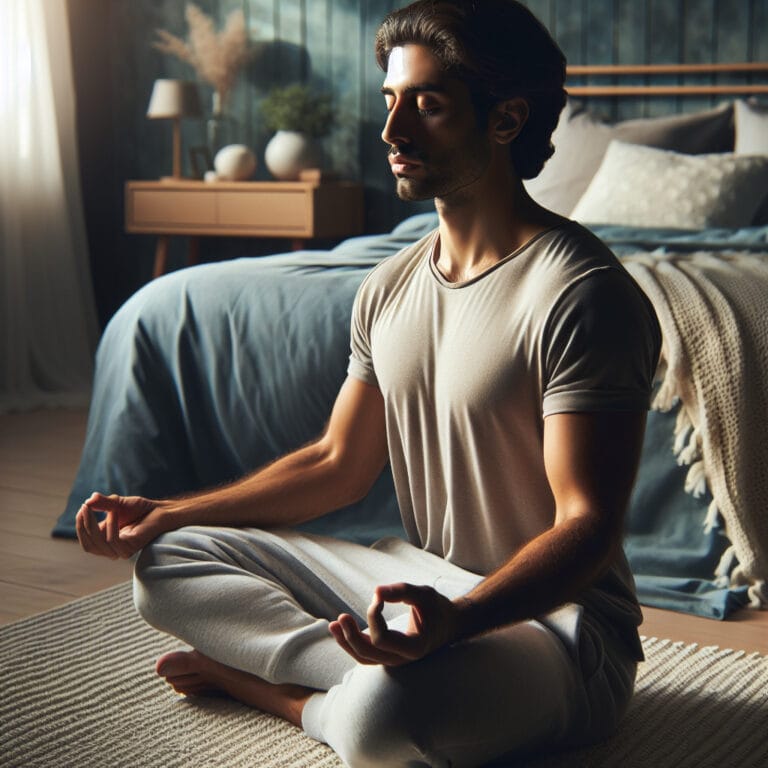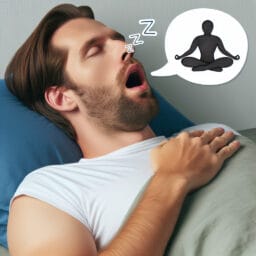
Effective Yoga Poses for Managing Sleep Apnea
Table of Contents
- Introduction
- Understanding Sleep Apnea
- The Role of Yoga in Managing Sleep Apnea
- Effective Yoga Poses for Sleep Apnea
- Tips for Practicing Yoga for Sleep Apnea
- Conclusion
- Frequently Asked Questions
Introduction
Embracing the healing power of yoga therapy could be a beneficial addition to your daily routine if you’re grappling with the challenges of sleep apnea. Characterized by repeated stops and starts in breathing, sleep apnea can result in numerous issues including headaches, high blood pressure, weight gain, and losing crucial hours of sleep. With obstructive sleep apnea (OSA), soft tissue at the back of your throat collapses and blocks airways during sleep. This is where yoga, particularly focusing on poses that strengthen upper airway muscles and expand blocked nasal and throat airways, comes into play.
Engaging in specific yoga poses as part of your daily routine can help manage bothersome symptoms associated with this common sleep disorder. For instance, ‘sleep yoga’ poses that focus on deep abdominal breathing can provide relief from sinus pressure while improving overall respiratory health. Furthermore, these exercises not only target the root causes for snoring naturally but also result in sounder nighttime slumber by reducing stress and promoting relaxation.
Remember to take proper guidance from a fitness expert or practitioner familiar with yoga for OSA patients. They will guide you through effective techniques to keep your airways open during sleep; significantly reducing instances where breathing stops momentarily – a key symptom diagnosis for OSA sufferers.
In essence incorporating targeted ‘sleep apnea yoga’ into your lifestyle may assist in managing symptoms while enhancing overall wellbeing – offering you more than just a good night’s sleep!
Understanding Sleep Apnea
Sleep apnea is not only a sleep disorder but also a significant health concern that affects millions worldwide. It’s characterized by the repetitive cessation of breathing during sleep due to the blockage of upper airway muscles, notably the soft tissue in your throat. This condition can lead to bothersome symptoms such as snoring and frequent disruption of sleep, causing you to lose valuable hours of rest at night. Furthermore, it could result in more severe problems including headaches, high blood pressure, and weight gain if left untreated.
The good news is that yoga therapy serves as an effective non-invasive treatment for obstructive sleep apnea (OSA), helping you manage this issue naturally. By focusing on specific yoga poses designed for OSA patients, these exercises work towards strengthening your upper airway muscles and keeping your nasal and throat airways clear while sleeping.
Imagine starting your day with deep ‘sleep yoga’ breathing exercises; inhaling slowly round after round as you embrace the healing power of yin yoga. These movements target not just the underlying causes contributing to snoring but also sinus pressure addressing common discomfort associated with OSA. The process doesn’t just stop at improving your physical wellbeing – it goes beyond by soothing your mind too!
Integrating such practices into your daily routine under proper guidance from a fitness expert can significantly reduce stress allowing for sounder night’s sleep – turning what was once a disturbing nightly occurrence into an opportunity for relaxation before bed!
Finally let’s not forget how beneficial this change could be for our loved ones; many partners face disrupted nights due to their partners’ nighttime disturbance caused by OSA – isn’t it time we gave them back their peaceful slumbers?
The Role of Yoga in Managing Sleep Apnea
Embracing the practice of yoga offers a glimmer of hope to those grappling with sleep apnea. The transformative power of yoga therapy ventures beyond the physical sphere, making it more than just a beneficial addition to your daily routine. By concentrating on certain yoga poses, you could help strengthen your upper airway muscles, ensuring your nasal and throat airways remain clear when you’re snoozing away. Indeed, ‘sleep apnea yoga’ is an excellent non-invasive strategy for managing not only bothersome symptoms but also underlying causes.
The implemented breathing techniques during ‘sleep yoga’ can be instrumental in dealing with this sleep disorder. It’s about inhaling slowly round after round, focusing on deep abdominal breaths that work wonders in expanding blocked nasal passages and relieving sinus pressure – common problems associated with obstructive sleep apnea (OSA). These exercises are aimed at reinforcing soft tissue in the throat area and preventing their collapse – one of the primary reasons behind OSA.
In addition to resolving physical discomforts like snoring naturally or maintaining open airways during sleep, these practices significantly reduce stress too. They provide a calming effect that can enhance overall relaxation and improve night’s sleep quality – an aspect highly valued by OSA patients who often lose vital hours of rest due to frequent disruptions.
However, practicing these poses requires proper guidance from a fitness expert or practitioner who understands the specific needs of those suffering from OSA. An integrated approach involving targeted movements not just promotes sounder slumber but brings about holistic wellbeing – truly harnessing the healing power that yoga is known for.
Effective Yoga Poses for Sleep Apnea
In the journey of overcoming sleep apnea, understanding the significance of certain yoga poses is crucial. By integrating these specific ‘sleep yoga’ exercises into your daily routine, you can harness their healing power to invigorate your upper airway muscles and unblock nasal and throat airways. These strategic body movements focus on strengthening the soft tissue in our throats that often relax and obstruct breathing during sleep – an integral part of any sleep apnea treatment plan. For instance, deep abdominal yoga breathing exercises have shown remarkable results in mitigating sinus pressure addressing one common facet of this complex sleep disorder problem.
Practicing these poses under a fitness expert’s proper guidance not only provides physical comfort but also helps you stop snoring naturally by keeping airways open as you slumber. Such practices significantly reduce stress levels too, offering mental solace which aids in improving sleep quality for those who constantly lose precious hours battling with this bothersome sleep issue.
Moreover, adopting Yin Yoga – known for its calming effects – can influence how efficiently we inhale slowly round after round; a technique pivotal to maintaining expanded airways during rest periods. In essence, dedicating time to such mindful activities doesn’t merely serve educational purposes for OSA patients; it contributes holistically towards achieving sounder nightlong repose that goes beyond treating symptoms diagnosis and offers an effective non-invasive approach towards managing obstructive sleep apnea effectively.
| Effective Yoga Poses for Sleep Apnea | |
|---|---|
| Importance of Yoga Poses for Sleep Apnea | Specific ‘sleep yoga’ exercises can invigorate upper airway muscles and unblock nasal and throat airways. They focus on strengthening the soft tissue in our throats that often obstruct breathing during sleep. |
| Benefits of Deep Abdominal Yoga Breathing Exercises | Deep abdominal yoga breathing exercises can mitigate sinus pressure, a common facet of sleep apnea. These exercises also provide physical comfort and help stop snoring naturally by keeping airways open during sleep. |
| Impact on Stress Levels and Sleep Quality | Practicing these yoga poses under proper guidance reduces stress levels and improves sleep quality by aiding in overcoming sleep apnea. |
| Role of Yin Yoga | Yin Yoga, known for its calming effects, can influence efficient inhalation and is pivotal to maintaining expanded airways during rest periods. |
| Overall Contribution | These mindful activities contribute holistically towards achieving sound sleep and offer an effective, non-invasive approach towards managing obstructive sleep apnea effectively. |
Tips for Practicing Yoga for Sleep Apnea
The journey towards managing sleep apnea can be transformative when you integrate yoga into your daily routine. The strategic power of ‘sleep yoga’ lies in the focused breathing techniques and poses that strengthen upper airway muscles, maintaining open nasal and throat airways during slumber. These exercises not only counteract symptoms like snoring but also alleviate sinus pressure; a common discomfort associated with this sleep disorder. However, it is crucial to proceed with caution when adopting these practices as an obstructive sleep apnea treatment. Every individual’s body responds differently to physical maneuvers hence it’s important to practice under proper guidance preferably with a fitness expert who understands OSA patients’ needs. They can offer advice on the best time for practicing ‘sleep apnea yoga’, how long each pose should be held, and ensure that you don’t strain or harm yourself in the process. Additionally, remember that this beneficial addition to your lifestyle should complement prescribed treatments from your healthcare provider; yoga therapy serves as an aid in managing symptoms diagnosis rather than a standalone solution to overcome losing sleep due to OSA issues. Embrace the healing power of yoga for sounder night’s rest while keeping safety at its core – because wellness is about holistic care!
Conclusion
Yoga therapy, with its intrinsic healing power, offers a promising approach in managing sleep apnea. Specific ‘sleep yoga’ poses are designed to fortify upper airway muscles, facilitating unblocked nasal and throat airways even when in slumber. This strategic alignment of breath and body can significantly alleviate sinus pressure and help stop snoring naturally – common issues associated with this complex sleep disorder. While yoga breathing exercises serve as an effective non-invasive strategy for obstructive sleep apnea treatment, it’s important to follow these practices under the proper guidance of a fitness expert familiar with OSA patients’ needs. By integrating ‘sleep apnea yoga’ into your daily routine, not only can you significantly reduce stress levels but also improve sleep quality – which is often compromised due to frequent nocturnal disruptions experienced by individuals battling this condition. Remember though; while adopting these beneficial additions to your lifestyle may assist in intricacies like symptoms diagnosis or providing relief from problems including headaches high blood pressure weight gain, they should ideally complement the prescribed treatments from a healthcare provider rather than replacing them entirely. For those losing sleep over bothersome sleep apnea, embracing the therapeutic essence of yoga might be just what you need for restoring sounder nightlong repose – all while adhering to safety guidelines for optimal wellness! However, severe cases warrant professional medical advice beyond these educational purposes because health is about holistic care.



